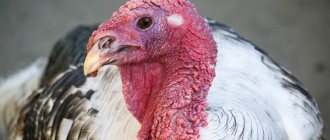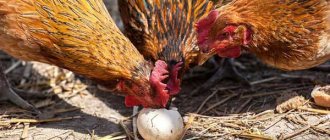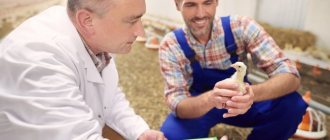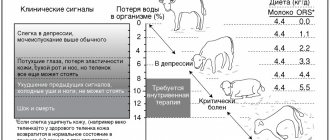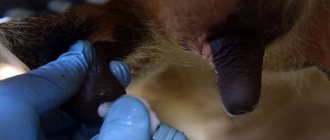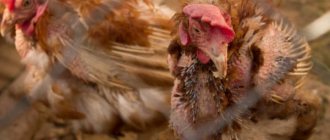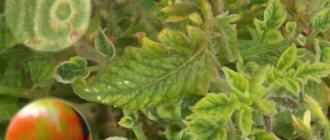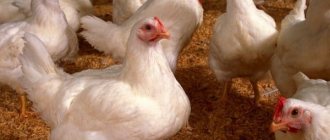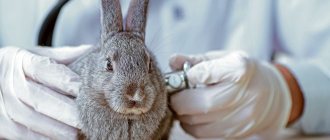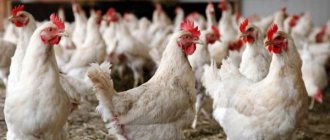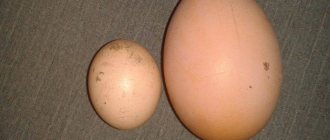Newcastle disease is a viral disease that is dangerous for birds. It is characterized by damage to the gastrointestinal tract, respiratory tract, and nervous system. It usually occurs acutely, is accompanied by a drop in the productivity of the livestock, and often ends in the death of individuals.
The disease is also known as Newcastle disease, pseudoplague, Asian, atypical or Brunswick plague, pseudoencephalitis, Doyle's disease.
In poultry farming, the virus is recognized as one of the most dangerous. It kills thousands of domestic animals every year, causing significant economic damage to small and large farms. For humans, pseudoplague is dangerous, but not fatal.
Newcastle disease is dangerous for birds
Pathogens
Newcastle disease is caused by an RNA paramyxovirus. The shape of the virus is round or rod-shaped. It depends on the type of virus, strain. Each strain has certain symptoms and a degree of pathogenicity (severity of the disease). Some of them are practically harmless, others are deadly.
Paramyxovirus that causes Newcastle disease
According to the degree of pathogenicity, the following strains of Newcastle disease are distinguished:
- velogenic (with the highest degree of pathogenicity);
- mesogenic (medium degree);
- lentogenic (low degree).
Newcastle disease strains have high viability
All strains have a common property - resistance to external influences of a physical and chemical nature. They are able to maintain their viability for a long time:
- in the bird’s habitat in cold weather - up to 5 months, in summer - up to 7 days;
- in buried infected bird bodies - up to 1 month;
- in dried organs of infected birds at a temperature of about +18°C - up to 2 years;
- in frozen carcasses of infection carriers - 1-2 years;
- in the body of tick carriers - more than six months;
- in the litter of a sick bird - about 20 days;
- when boiling an infected carcass - up to 60 minutes.
History of the discovery of Newcastle disease
Treatment of the disease
The Newcastle disease virus quickly dies when exposed to ultraviolet light.
No specific treatment for Newcastle disease has been developed; due to the danger of spreading the infection, sick individuals are destroyed. A bird that has recovered from pseudoplague develops strong immunity.
In chickens
Chickens are the most susceptible to infection, therefore, for prevention purposes, the livestock is vaccinated. As a result, antibodies accumulate in the body that can neutralize the virus and prevent it from adhering to blood cells.
Their number is affected by:
- type of vaccine;
- frequency of application;
- time of administration.
A bird that is immune passes on antibodies to its offspring, developing resistance to the virus.
Geese
Strong immunity often prevents the disease from developing; first of all, geese are carriers of the disease. An asymptomatic course threatens infection not only for chickens on the farm, but also for humans, so young animals also need to be vaccinated.
At the ducks
Ducks tolerate the disease well; symptoms may appear in weakened individuals. Waterfowl are carriers of infection, so it is important to vaccinate young animals and take measures against infection.
Be sure to read:
Treatment and prevention of various types of diarrhea in hens and chickens
In turkeys
Turkeys are susceptible to all forms of Newcastle disease and die en masse, especially young animals. Only preventive measures and a vaccine save the bird.
In other birds
Measures to prevent infection of birds of other breeds do not differ from those suitable for the varieties described above. Only prevention and timely vaccination will help preserve a healthy bird population.
Which birds are at risk?
Absolutely all birds are susceptible to Asian plague. And if there is no way to take care of wild birds, then domestic and farm birds should be especially protected from this virus.
Galliformes (chickens, partridges, turkeys, guinea fowl, etc.) are most often infected. Newcastle disease threatens, although to a lesser extent, pigeons, parrots, sparrows, hawks, and ostriches.
Chickens are more susceptible to Newcastle disease than other birds.
The organisms of geese and ducks are resistant to the strains, but they are carriers. Laying hens act both as victims of the virus and as its carriers.
Geese and ducks are resistant to paramyxovirus, but are its carriers
Young animals become infected more often than adults. Birds with weak immune systems also easily contract the disease.
The virus can infect some primates and humans. But for them it is not fatal; the disease proceeds as a simple respiratory infection. But it should be treated promptly so that the virus does not spread to its main victims - birds.
Signs and forms of atypical plague
The severity of pseudoencephalitis depends on the strain of the virus and whether the livestock has been vaccinated.
The acute course of Newcastle disease is most often observed in unvaccinated poultry. The disease develops rapidly and affects the entire herd in less than three days. The mortality rate often reaches 100% in 2-3 days. Characteristic symptoms of the acute form of atypical plague are:
- refusal of water and food;
- labored breathing;
- high temperature up to 44 °C;
- decrease in activity up to its complete absence;
- drooping of the head;
- flow of mucus from the nose and beak;
- green diarrhea, sometimes with blood;
- sneezing and coughing;
- breathing through an open beak;
- blurred eyes and inflammation of the conjunctiva;
- stretching the limbs and throwing back the neck;
- severe exhaustion.
Appearance of a sick pigeon
In vaccinated broiler and turkey chickens, pseudoplague has a subacute course, which also affects the nervous, digestive and respiratory systems. This form is characterized by:
- increased excitability;
- impaired motor coordination;
- bending and twisting of the neck;
- convulsions and shaking of the head;
- lack of movement of wings, paws, neck and tail;
- difficulty breathing;
- wheezing during breathing;
- green watery diarrhea;
- swelling of the eyelids;
- purulent inflammation of the conjunctiva of the eyes;
- exhaustion.
On large poultry farms, where regular vaccination of young animals is carried out, the virus is almost constantly present in the environment. As a result, the disease takes on an atypical course, which is characterized by:
- decreased egg production;
- damage to the respiratory system after vaccination of chicks;
- eye inflammation;
- minor damage to the nervous system;
- decreased hatchability of chicks.
Mortality in atypical course of the disease does not exceed 15%.
Sometimes Newcastle disease has a fulminant course, in which the bird dies before the first symptoms appear. Or it acquires a chronic form, which kills 10–20% of the entire herd. In addition, there is an asymptomatic form of the disease, which occurs in the form of an intestinal infection.
In addition, there are several other forms of Newcastle disease, which are presented in the table:
- Acute course;
- about half of the entire herd dies;
- especially dangerous for young animals, killing almost the entire brood
- Cough;
- hard breath;
- eye inflammation;
- mucus discharge from the beak
- Acute course;
- death of 90% of sick individuals, regardless of age and type of poultry
- Weakness;
- absolute loss of appetite;
- inflammation and clouding of the eyes;
- convulsions;
- accumulation of mucus in the respiratory organs;
- immobilization of paws and wings;
- watery droppings;
- internal bleeding in the digestive organs
- The mortality rate of adult birds is no more than 33%;
- Almost all young animals die;
- the virus strain of this form of the disease is used as a secondary vaccination with a live vaccine
Severe damage to the central nervous system in chicks
- Light flow;
- virus strain used to produce vaccine
- Lethargy;
- decreased appetite;
- decreased egg productivity;
- eggshells are very thin or missing completely
Spread of the virus
The source of the pathogen is an infected or recovered individual. From her body, strains are released into the environment during breathing, with secretions and eggs.
An infected broiler is the source of the virus
Infection carriers: birds, humans, rodents, insects, pets.
The virus is transmitted through:
- food products obtained from infected poultry (eggs, meat);
- raw materials from the habitat of the sick individual (down, feathers, food, water, perches, bedding);
- equipment that was in an infected place;
- poultry house worker's clothing or shoes;
- the corpse of a sick chicken, turkey, etc.
Paramicroviruses can be transmitted through the clothing of poultry workers
Within a day after entering the body, the virus is able to spread further through a new carrier.
Attention! Researchers have found that the radius of infection can reach ten kilometers!
In poultry houses, the virus is transmitted through the ventilation system and quickly leads to mass mortality of individuals.
The ventilation system of the chicken coop contributes to the spread of the virus
Newcastle disease often has a periodic character. This is explained by the fact that it is difficult to get rid of the causative agent of the virus completely: it remains viable for a long time without visible signs in the host’s body and in the external environment. If you encounter this disease once and fail to properly carry out all preventive measures, be prepared for history to repeat itself.
Pathogens are especially often activated in summer and autumn, when the number of poultry increases to its maximum.
Newcastle virus becomes active in summer and autumn
If chickens and other birds are not vaccinated, then the probability of infection is maximum - 90-100%. In this case, death is guaranteed in 40-80% of cases.
Sources of infection
The main sources of infection are sick chickens.
The infectious agent of Newcastle disease are strains of the paramyxovirus family of viruses containing single-stranded RNA.
Attention! Chickens are highly susceptible to the virus, young animals are especially sensitive. There have been outbreaks of disease in chickens when adults remain healthy. Ducks and geese show resistance to pseudoplague, but are carriers and conductors of infection.
The source of infection is infected poultry: sick, during the incubation period, a survivor of the disease, a latent carrier. Rodents, ticks and wild birds also spread the infection.
The virus is present in the saliva and blood of chickens, as well as in all organs, the contents of the intestines, and penetrates into eggs.
A day before the manifestation of symptoms, the pathogen begins to be excreted in saliva and feces, infecting surrounding objects, food and water.
Be sure to read:
Why the comb of chickens and roosters turns blue: reasons, what to do, preventive measures
When dry, the particles mix with the dust that chickens inhale and settle on the feathers.
The virus enters the bird's body:
- through the respiratory organs (aerogenously);
- through the esophagus (the nutritional route is less common).
Isolated cases include infection through small wounds on the body and oral mucosa.
Factors of infection transmission are:
- raw materials and poultry products;
- non-disinfected clothing or shoes used in a poultry farm;
- transport and containers in which eggs and poultry are transported;
The movement of the pathogen over significant distances is facilitated by the operation of the ventilation systems of the poultry house: when there is wind, viruses scatter over 5 kilometers.
Birds that have died from Newcastle disease are disposed of, sick individuals are placed in a separate room
Symptoms and course of Newcastle disease
The incubation period of the disease is short. It lasts from 3 to 12 days. The clinical picture may vary. It is determined by the specific strain that infected the bird. The age and physiological characteristics of the individual and the conditions in the poultry house are decided. Nevertheless, the disease can be diagnosed based on signs characteristic of all its forms.
Lethargic chicken sick with pseudoplague
Common symptoms of Newcastle disease
Pseudoplague is accompanied by the following changes in the behavior and condition of the bird:
- elevated temperature, up to 44 degrees;
- loss of appetite;
- refusal to drink;
- decreased activity, mobility, apathy, drowsiness;
- blurred vision, conjunctivitis;
- breathing problems, coughing, coughing;
- mucous discharge from the beak;
- loss of healthy coordination of movement, up to paralysis;
- intestinal disorders, diarrhea may be yellowish-green in color, mixed with blood.
Poultry conjunctivitis
All birds show the same signs of infection. The symptoms of Newcastle disease in chickens are the same as in pigeons or turkeys.
How does the virus progress?
The course of the disease can take several forms. The differences between them are presented in the table. The characteristic features of the type of disease are determined by the strains.
| Shape - characteristic | Lightning fast | Acute (velogenic) | Subacute (mesogenic), pseudoencephalitis | Chronic (lentogenic) | Atypical (asymptomatic), immune-forming subinfection |
| Strains that caused the disease | all highly pathogenic | Asian strains of highly pathogenic type | mesogenic | lentogenic | weakly virulent |
| Who is susceptible | unvaccinated and weak individuals | unvaccinated birds | vaccinated chickens and chicks of other birds | birds with strong immunity | young animals |
| Death after infection | after 2-3 hours | in 3 days to a week | on average after a week | in 5-12 days | rarely happens |
| Probability of death | 100% | can reach 100% | 50% and below | from 15 to 30% | no more than 15% |
| Main symptoms | no symptoms | all common ones are clearly expressed | cough, shortness of breath, excitability, convulsions, severe exhaustion | excitability, convulsions, rapid exhaustion | decreased egg production, characteristic signs are not expressed |
The methods of dealing with any form are the same. But the more severe the disease, the more quickly you need to act in the fight against the disease.
Twisting the neck of a sick bird
Newcastle disease: general description
Other names for this disease are pseudofowl plague and Asian fowl plague , the causative agent is a virus from the group of paramyxoviridae or Paramyxoviridae.
The Newcastle disease virus is not dangerous to humans, but after contact with an infected bird, a person may develop an illness resembling mild conjunctivitis or the flu. Newcastle disease in birds is characterized by:
- pneumonia - inflammation of the lungs;
- encephalitis - inflammation of the brain of the head;
- damage to other internal organs, accompanied by hemorrhages.
Historical information
Newcastle disease was first identified in birds in 1926 by Kraneveld .
A year later, it began to be diagnosed in various countries in America, Europe and Asia. At the same time, a researcher from England, Doyle, identified this disease near the town of Newcastle and gave the disease the name by which it is still known today. Scientists from the USA first described the disease in 1935, and they called it chicken pneumoencephalitis. In the early 40s of the 20th century, the disease became widespread in European countries.
Economic damage
Newcastle disease in birds can occur in various forms, differing in severity and symptoms.
During a mild form of the disease, the bird weakens, its egg production and meat production decreases; in severe forms, the bird dies without treatment. Pseudoplague can lead to the death of a significant number of chickens and turkeys. Newcastle disease causes great economic loss - when severe, up to 95% of affected birds die. In addition to livestock losses, significant costs are caused by the implementation of quarantine and preventive measures. When vaccines are used on private farms, their use is most expensive.
We also recommend reading:
Ideas for a warm chicken coop Chinese silky chickens are unique cuties Exotic breeds of chickens that lay colorful eggs Magic for everyone: how to hypnotize a chicken
Diagnostics
After examining the inhabitants of the poultry house and even after autopsying a deceased individual, only a preliminary diagnosis can be made based on clinical signs and pathological-anatomical changes.
At first, it is important to differentiate the disease. You need to be able to distinguish it from chicken flu and bronchitis, smallpox, pasteurellosis, poisoning, paramyxovirus infection, infectious bursitis and laryngotracheitis, etc.
Only a veterinarian can make an accurate diagnosis
An accurate diagnosis can be made with an integrated approach. It is necessary to do detailed laboratory tests, which will be prescribed by a veterinarian.
Laboratory tests are an important part in diagnosis
Video - How to diagnose a bird?
Invasive (parasitic) diseases
Invasive diseases can appear in cases of infection by external parasites, helminths and protozoa intracellular organisms.
External parasites
The most common external parasites are fleas, ticks and feather eaters. Chickens are especially hard-pressed to cope with the invasion of feather eaters. In this case, individuals experience loss of appetite, lethargic behavior, and skin inflammation. In adult individuals, premature molting may occur, and pecking of their own plumage may occur.
Coccidiosis (eimeriosis) of chickens
This unpleasant disease in chickens is caused by spores of the fungus eimeria, which is why coccidiosis is called chicken eimeriosis. Chickens aged 5–80 days are most susceptible to the disease. The danger is that a bird that has recovered from the disease remains a carrier of the disease forever. Eimeriosis is promoted by crowding of adult birds in the chicken coop and chickens in the brooder, high humidity, and unsanitary conditions.
Mechanical carriers can be rodents and service personnel. The pathogen is resistant to most antimicrobial drugs and is completely killed when dried or exposed to high temperatures.
That is why it is important to timely clean the brooder and chicken coop, regularly change the litter, and process feeding equipment, especially for chickens under 10 days of age.
The incubation period is 5 days. Chicks do not eat for up to 10 days and die quickly, mortality reaches 100%. Older young animals experience severe thirst, loss of appetite, and in prolonged cases – paralysis and convulsions. The chicks stretch, trying to straighten their wing and leg at the same time. The disease lasts about a week, the mortality rate of young animals reaches 85% - 90%.
To treat chickens, medications are used that do not interfere with the development of immunity. The drugs “Amprolium”, “Coccidiovit”, “Iramin”, “Sulfadimezin” are effective. However, the high degree of adaptation of eimeria to drugs should be taken into account. For successful treatment, drugs must be alternated.
Helminth infection
Chickens do not tolerate helminth infections well and in advanced cases may die. Infection with worms appears in young animals at the age of three to four weeks. You can notice parasites in poultry droppings. Infection occurs through the consumption of pasture, as well as through irregular changes of filler in a sand-ash bath, through rodents and insects.
With helminthiasis in chickens, there is a deterioration in appetite, lethargy, heavy breathing, diarrhea, pale scallops, weight loss, and developmental cessation. It is necessary to treat helminthiasis not only in sick individuals, but in the entire livestock. For these purposes, you can purchase the drugs “Flubenvet”, “Piperazine”, “Levamisole”. These medications have a universal effect and are aimed at combating the most common types of helminths.
How to fight the virus?
There are no special medications for pseudoplague. It is not advisable to treat a sick bird, especially when it comes to poultry farming. This can lead to infection of the entire livestock. Therefore, a sick individual is disposed of by strangulation. After this, it should be buried deeper and covered with quicklime to completely destroy the pathogen. You can burn the corpse.
Sick birds must be slaughtered
The best way to combat the virus is vaccination. It is also important to follow general preventive and disinfection measures.
Recommendations for preventing the spread of the disease
In Newcastle disease, all NDVs can lead to temporary conjunctivitis in humans, but the condition has been limited primarily to laboratory workers exposed to a large number of viruses. Before vaccination of poultry was widely practiced, conjunctivitis from NDV infection occurred in crews who handled poultry in processing plants. The disease has not been reported in people who raise poultry or consume poultry products. If such viruses are detected at your enterprise, quarantine should be introduced for a period of at least 30 days to regulate the situation in the poultry house. During the quarantine period, the farmer should restrict the entry of unauthorized people into the enterprise.
When working with infected chickens, you need to wear protective clothing and gloves. After working with infected chickens, it is necessary to completely disinfect the chicken coop, clothing, and equipment. If you managed to prevent the spread of the virus outside your poultry house, then you need to follow the recommendations. You cannot sell meat or eggs from birds that have been diagnosed with Newcastle disease. The chicken coop should be completely disinfected, and the bedding should be replaced with new ones. If perches are contaminated with feces and secretions from infected birds, they should also be replaced.
Even after quarantine is lifted, individuals remain under constant surveillance and are considered for some time to be carriers of the Newcastle threat virus.
In order not to make your company bankrupt, you should take all preventive measures to prevent such an infection. First of all, it is recommended to vaccinate chickens without fail. If you know that there is a poultry farm in the area within a radius of 10 km and an outbreak of Newcastle disease was recorded there, then the chickens are vaccinated out of turn. After the vaccine is given and several weeks before it is given, the birds' diet should be changed. It is necessary to add more vitamins and a variety of foods to the daily menu to strengthen the chickens’ immunity.
Vaccination
It must be carried out on poultry from 4 months of age, preferably twice. Vaccination at one month of age is possible. It is enough to vaccinate broilers once from the tenth day of life. Adults are vaccinated when there is an urgent need, since the procedure reduces the productivity of laying hens and other birds.
It is enough to vaccinate broilers once from the tenth day of life
It is advisable to vaccinate in spring and autumn. Immunity after using the drug occurs on the third or fourth day. Protection can be provided for a period of 2 to 12 months. The period depends on the type of vaccine, the age of the birds, the quality of food and maintenance.
Important! Don’t forget to enrich your birds’ diet with vitamins A, B and D before and after vaccination to strengthen the birds’ immunity and general condition. Vitamin supplements should be given for at least 10 days.
Vitamin complex Trivitamin
Types of vaccines
Drugs for protection vary in their degree of aggressiveness. In total, there are three groups of vaccines against pseudoplague:
- inactivated;
- live naturally weakened;
- live laboratory weakened.
Vaccination of pigeons
Inactivated drugs are the safest for birds and are suitable for combating several infections. They have a mixed composition with strains.
Live vaccines provide protection quickly, but not as long-lasting. The validity period is usually 2-3 months. They are made based on the strains La Sota, N, Bor-74, HB1, V4, VG/GA, Ulster 2C, PHY.LMV.42.
Live vaccines are reactogenic: they cause complications in the form of respiratory diseases and decreased productivity. To avoid unpleasant consequences, it is important to follow the instructions for use and not skimp on vitamin supplements.
On a note! In Europe, for more than 10 years, there has been a ban on the introduction of vaccines based on the La Sota strain due to its high reactogenicity. In the Russian Federation, preparations containing it are used everywhere in poultry farming and are recommended by veterinarians.
LaSota strain banned for use in Europe
Recommendations
Currently, there are dozens of drugs for vaccinating birds against Newcastle disease. There is no significant difference between them. But a few nuances are worth considering:
- to vaccinate day-old chicks, do not use preparations with strains VH, C2, B1, Hitchner, they can negatively affect development;
- in a rural farmstead the Clone-30 strain will be weakly effective. It is suitable for vaccinating individual birds, pet parrots, for example;
- in a situation of a large outbreak of the virus, it is recommended to use drugs containing strains H and GAM-61;
- in rural farmsteads, vaccines containing the La Sota and Bor-74 strains are often used (“VGNKI”, “ARRIAH”, “Avivak”, etc.);
- Please note that the drugs have different dosages (100, 200, 5000 doses, etc.), follow the instructions.
Newcastle disease vaccine
Disease overview
Three strains
The cause of Newcastle disease (plague) is a virus of the paramyxovirus family. It manifests itself in three strains, differing from each other in the extent of damage to the chicken body.
The lentogenic virus causes minimal harm to the body, and the disease passes without symptoms.
With the mesogenic strain, the pathology occurs in a mild form, causing inflammation of the respiratory system and neurological disorders in the form of whirligig in chickens.
The most severe virus is velogenic. If a chicken becomes infected with it, it dies.
The virus tolerates negative environmental influences well. In cold weather it lives up to six months, and in water it can survive for about two months.
The virus remains active for a long time while in a chicken coop; it can even settle in eggs and live there for six months.
The pathogen can remain in the refrigerator for several years and remain active, but when exposed to sunlight it will die in 2 days. If the virus heats up to 100 degrees, death will occur immediately.
Virus carriers
The virus is transmitted through a chicken if it gets sick, suffers the disease, but remains a latent carrier. Or the pathology is in incubation translation.
In addition, rodents, wild birds, and insects are spreaders of Newcastle disease.
Transfer methods
The causative agent of the disease is found in the blood and saliva of chickens. The day before the end of the incubation period, it begins to be released into the environment along with saliva and excrement. The virus ends up on the litter, in feeders, drinkers and other objects with which the bird interacts.
Birds can become infected through the respiratory system and gastrointestinal tract. Occasionally, the pathogen enters the body through scratches on the body and oral mucosa.
The infection is transmitted through food, equipment, clothes and shoes of the owners, machines and equipment used to transport chicken. The virus can quickly spread over several kilometers with strong winds or good ventilation.
The chicken body is highly susceptible to the pathogen. Chickens are especially affected. An epidemic of Newcastle disease may begin in a chicken coop, but only young birds will become ill.
What happens to the body after the virus hits?
Once in the chicken’s body, the virus immediately penetrates the circulatory system. After a maximum of half a day, the infectious agent begins to multiply. Through the blood it reaches organs and tissues, breaking the barrier between the nervous and circulatory systems.
As a result, the viral particle begins its pathogenic work in the brain and nervous system.
The virus interferes with the functioning of the body, causing problems with blood circulation, disturbances in the functioning of the heart muscle, and hemorrhages in internal organs.
Due to the pathogenic effect on the nervous system, chickens begin to develop encephalomyelitis, an infectious disease that affects the brain and spinal cord. Changes in the chicken’s body lead to the appearance of symptoms of the disease.
The immune system of a recovered bird actively produces antibodies. If laboratory tests are carried out after a week, they will not show the presence of the virus in the blood and tissues. After about 4 months, the virus completely disappears from the internal organs and excrement of chickens.
How to vaccinate?
Depending on the scale of infection, the age of the birds and the severity of the infection, vaccination can be done using the following methods:
- spraying a spray on an individual one day old;
- individual instillation into the nose or eyes (intranasal or ocular method);
Vaccination by individual instillation
- by feeding if the livestock is infected (enterally).
Vaccination by drinking
How to spray vaccine onto chickens?
Step 1: Turn off ventilation in the poultry house to reduce air flow and reduce the risk of movement of virus strains.
Step 2. Place day old chicks in a box. If there are several boxes with individuals, then place them tightly one to one. There are special spray booths for these purposes; they are already equipped with sprayers.
Spray booth for vaccination
Step 3. Immediately before use, the vaccine is dissolved at the rate of 1000 doses of the drug per 200 ml of water for day-old chicks. If you plan to vaccinate older chicks, this dosage is per liter. The temperature of water free of chlorine and iron should be between 21 and 28°C.
Preparing to Spray Chicks with Vaccine
Step 4. Dim the lights to calm the birds' agitation.
Step 5. Pour the solution into the built-in sprayers in the box, or into any other non-special spraying structures. The main requirement for the container: corrosion resistance and sterility.
Manual aerosol sprayer
Sprayer prices
Spray
Step 6. Spray the vaccine evenly from a height of 30-40 cm above the chicks.
After the procedure, it is worth keeping the treated individuals isolated for 3 days.
How to carry out instillation?
Step 1. Pour sterile saline solution into the vaccine bottle. Calculation: 0.1 cm3 per 1 dose (intranasal or ocular).
Step 2. Pour the prepared solution into a sterile pipette.
Step 3. Place two drops into one nasal slit and close the other with your finger. If the nasal slits are clogged, apply eye drops in the same way.
Putting eye drops on a chicken
How to solder?
Step 1. Calculate the dosage. To do this, track how much water one individual drinks in 1.5 hours. 10 intranasal doses are sufficient for this volume.
Step 2. Limit birds' access to water. Keep meat birds away from drinking bowls for two to three hours. Leave the hens without water for 6-8 hours.
Step 3. Wash all drinking bowls thoroughly. Do not disinfect.
Before vaccination, all drinking bowls must be thoroughly washed.
Step 4. Dilute the vaccine in clean water, free of iron and chlorine. Its temperature should be room temperature, up to 25°C. We prepare the solution for the entire livestock, following the dosage (see Step 1). You can add skim milk powder (calculation - 5%) to it for better dilution.
Step 5. Fill all drinkers with the prepared solution and open access to them.
Step 6. Give regular drinking water two hours after the vaccine has been drunk.
Regular water is given after the vaccinated person has drunk
The vaccination recommendations below indicate general schedules. Be sure to read the instructions for the specific drug you are using and follow them.
Clinical picture of the pathology
Lightning form
The course of the disease depends on the strain, activity of the virus, the age of the bird and the condition of the body.
The fulminant form is characterized by the absence of symptoms. A large number of roosters and hens suddenly die, and autopsies reveal the presence of the causative agent of Newcastle disease.
Acute
In this case, the disease manifests itself as hemorrhages in the respiratory and gastrointestinal tract. The nervous system suffers greatly, so the sick chicken constantly turns its head.
The bird dies a maximum of four days after the infection enters the body. In the acute form of the disease, the farmer loses up to 100% of his livestock.
Subacute
This form appears when a mesogenic strain of virus enters the body. The chicken's egg production decreases, the shell becomes thinner, and a thin film may appear instead.
Sick birds behave excitedly. About 30% die, mostly young individuals.
Chronic
The illness lasts about 30 days. The pathogen attacks the central nervous system.
In the chronic form of the disease, 30% of the herd dies.
Atypical
This form of Newcastle disease occurs when the virus is weakly active. Chickens with strong immunity that have been vaccinated suffer from an atypical pathology.
In this case, the disease is characterized by the absence of symptoms. The nervous system remains intact or is not immediately affected. Up to 85% of sick chickens survive.
Preventive measures
Vaccination is not the only or primary means of combating Newcastle disease. It is imperative to follow preventive measures to prevent the virus from appearing.
Poultry house disinfection
The set of sanitary and veterinary standards includes:
- disinfect the poultry house twice a year (phenol, ethyleneimine, chloroform, formaldehyde, betapropiolactone, etc., generally accepted concentrations);
- if it is impossible to provide access to sunlight: use lamps with ultraviolet radiation in the habitat of chickens and other birds (it is detrimental to pseudoplague strains);
- ventilation openings and windows in the bird habitat must be covered with bars to prevent the entry of wild infected birds;
- in a large farm with several poultry houses, each room must have separate labeled protective clothing;
- New imported livestock cannot be immediately placed with the old one; it should be kept in isolation for a month;
- Treat poultry meat and eggs with boiling water before consumption.
What to do with sick individuals and the poultry house
It is useless to treat chicken worms - in most cases the birds will die anyway. In addition, the disease is highly contagious, so it quickly spreads throughout the poultry house.
The main task of the breeder is to do everything possible to prevent the infection from spreading to neighboring safe farms.
Immediately after the first signs of the disease appear, a quarantine is declared on the farm. It is prohibited to export birds, hatching eggs, excrement and other waste.
Dead birds are destroyed, healthy ones are examined and then vaccinated. If it is decided to slaughter chickens for meat, then the internal organs, feathers and down must be burned.
The chicken coop and all equipment must be disinfected with formaldehyde solutions or sodium hydroxide. The preparations are very toxic, so before disinfection all birds are removed from the premises.
It is necessary to carry out disinsection and deratization to get rid of parasites and rodents. The litter must be burned, because it may contain a pathogen.
Quarantine
If after laboratory tests an official diagnosis is made, then the entire farm is quarantined for a period of 1 month. It is mandatory to notify local authorities, veterinary services, supplying farms and partners (if we are talking about an enterprise) about the virus.
At this time, the territory of the poultry farm is fenced off and access to unauthorized persons is prohibited. The supply and export of birds is suspended, trade in meat and egg products, down and feathers is stopped. Incubation of eggs is prohibited.
Disinfection at a poultry farm
All sick and young individuals, as well as “possibly sick” ones, are subject to destruction. This must be done in a bloodless manner; strangulation is recommended. To prevent the spread of the pathogen, windows, doors, and hoods must be closed during the process. Afterwards, the corpses are immediately destroyed in incinerators or pits. The depth of such pits should be from 2.5, width - from one and a half, depth - at least 0.7 meters. The place of destruction, the equipment used in this process must be disinfected after the destruction of birds.
Clinically healthy adult birds are vaccinated and kept in isolation. It is recommended that even uninfected individuals in quarantined farms be slaughtered. The meat of such birds must be thoroughly processed (boil for at least an hour) before consumption.
All birds on quarantined farms are subject to slaughter
Previously vaccinated healthy birds in an infected poultry house can be revaccinated.
Before the end of quarantine, the poultry house is completely disinfected.
Attention! Metal equipment is not resistant to bleach and caustic alkali. They are disinfected with formaldehyde. Processing method: wet or aerosol.
Sometimes Newcastle disease causes mass mortality of birds. Then the quarantine is established for five days. During this period, all individuals are destroyed and the area at risk of contamination is completely disinfected.
Disinfection service
Prices for disposable laminated overalls
Disposable Laminated Coverall
Is it possible to save a bird?
Newcastle disease can lead to the death of a large number of chickens.
Pseudoplague cannot be treated , the virus has highly contagious properties, so measures to save the livestock are not only useless, but also dangerous.
Important! The infection is spreading rapidly.
To prevent the disease from spreading to healthy farms, the following actions are required to eliminate the epizootic focus:
- a quarantine is declared on the farm with a ban on the export of poultry products and waste;
- sick chickens are slaughtered and the corpses are destroyed;
- after a laboratory examination, a healthy bird is vaccinated or slaughtered for meat, burning internal organs and feathers;
- carry out disinfection of premises and equipment with solutions of xylonaftha-5, formalin, caustic soda or carbolic acid;
- carry out disinsection and deratization of premises:
- droppings and litter are burned and isolated on an industrial scale for disinfection by biochemical processes.
Be sure to read:
Large goiter in a chicken: what to do, causes and treatment
The quarantine is lifted 5 days after the slaughter of the entire livestock, or after a month if no cases of the disease have been detected.
Newcastle disease and humans
The virus does not pose a danger to people. People sometimes become infected by direct contact with sick chickens and other birds. The infection enters the human body through airborne droplets: by inhaling dust with strains. The virus can be transmitted to the eyes by hands contaminated after working in the poultry house.
The incubation period of infection in humans lasts from 3 days to a week.
It is better to wear gloves when working in a poultry house
Symptoms:
- flu-like symptoms (general weakness, nasal congestion, lack of appetite, slight increase in temperature);
- minor conjunctivitis with redness of the eyelids;
- mucous or purulent discharge from the eyes and nose (sometimes);
- diarrhea - sometimes, even less often - with blood;
- In severe cases, an infected child experiences brain damage.
Symptoms of pseudoplague in humans are similar to flu symptoms
Protecting yourself from bird disease is not difficult. It is important to follow basic sanitary and hygienic rules:
- After working in the poultry house, be sure to wash your hands with soap and disinfect them;
- poultry meat and eggs must be heat-treated before consumption; they cannot be consumed raw;
- use a respiratory mask when vaccinating chickens with an aerosol or during disinfection measures;
- At the first suspicion of infection, consult a doctor.
Be sure to use a respiratory mask when vaccinated
Is the disease dangerous for people?
People are susceptible to the virus, but infection does not threaten human life.
A person can catch this virus
At risk are farm workers who have been in contact with sick poultry, as well as those who have eaten infected poultry products that have not been subjected to sufficient heat treatment.
The disease manifests itself with flu-like symptoms 3-7 days after the pathogen enters the body, accompanied by signs:
- weakness and loss of appetite;
- increased temperature;
- rhinitis;
- diarrhea, sometimes with blood inclusions.
When a pathogen enters the eye mucosa, it results in inflammation of the conjunctiva.
Important! Careful hygiene practices will help reduce the risk of infection. If infection is suspected in a child, hospitalization is required to prevent the development of complications.
Signs of the disease
The first signs of the typical form are depression and weakness of the bird, loss of appetite and fever. Symptoms of disorientation associated with deterioration of the central nervous system can often be observed. In more than half of the sick birds (40-70%), an increase in goiter is noted. The droppings become liquid with admixtures of mucus and blood.
When breathing, you can hear specific sounds caused by the accumulation of exudate in the respiratory tract. Often the bird begins to sneeze and breathes with its beak open. Damage to the nervous system leads to the development of paralysis, as a result of which the neck may become twisted, ataxia and tremor may develop, the movement of the limbs becomes more difficult, wings droop, and the like.
Among the generalized manifestations of the disease, one can notice a decrease in egg production, as well as a slowdown in growth and development. Already in the first week after infection, vitelline peritonitis and kerato-conjunctivitis can develop.
Review of diseases
Broilers, like any other fast-growing birds, are very delicate, whimsical creatures. Growing meat crosses requires certain knowledge and increased attention to the health of poultry. As a rule, broiler chickens get sick in the first months of their life. The risk of contracting a dangerous infection increases from the 1st to the 5th day and from the 24th to the 35th day from birth. Day-old broilers are especially vulnerable, so chicks require increased attention. They suffer from viral, bacterial, parasitic diseases, and non-communicable diseases.
Among the diseases of chickens that are most often diagnosed in veterinary practice are:
- colds;
- helminthic infestations;
- contagious diseases;
- disturbances in the functioning of the digestive tract;
- hypo-, avitaminosis, rickets;
- Marek's disease;
- dyspepsia;
- coccidiosis;
- Newcastle disease;
- pullorosis;
- aspergillosis;
- joint diseases (arthritis).
The infection spreads very quickly from a sick chicken to healthy chickens. Some broiler diseases, if treatment is not started in a timely manner, can cause the death of the entire chicken flock, which will entail large financial losses.
Important! In addition to infectious diseases, respiratory diseases (sinusitis, bronchitis, pneumonia, bronchopneumonia) very often cause the death of small chickens. Having noticed the symptoms of such ailments, the farmer must know how to treat colds and diseases, as well as what to take as a preventive measure to prevent infection of the chicken population
Infection of young broilers occurs through airborne droplets, nutrition, and contact. Chickens can pick up a dangerous infection from other poultry, hidden (latent) virus carriers. The risk group includes chickens with weak immune systems and birds kept in unfavorable conditions.
Improper care, unbalanced nutrition, feeding poultry with low-quality, low-grade feed very often leads to the development of non-contagious diseases in broiler chickens. For example, a lack of calcium, phosphorus, and vitamin D will lead to rickets. The chicken begins to fall and sit on its legs. The joints are thickened, the bird becomes inactive, and the condition of the feathers deteriorates. Non-contagious diseases of chickens can also cause death of birds.
In case of broiler diseases, the symptoms and their severity depend on the age, the state of the bird’s immune system, the type of infection, and the root cause that provoked the disease in the birds. Treatment should begin as soon as the first symptoms of illness appear. Let's look at the main diseases of broilers and tell you how to treat infectious, parasitic, and respiratory diseases.
Routes of infection
The main routes of infection with Newcastle disease are nutritional and aerogenic, as well as contact when healthy and sick livestock are kept together. At the same time, the aerogenic method of spreading the virus is the fastest. In prosperous farms, the pathogen is usually introduced with hatching eggs.
Most often, Newcastle disease manifests itself in the form of an epizootic, has a certain periodicity and a tendency to the summer-autumn season. This seasonality, in turn, is associated with increased economic activity and an increase in the number of poultry at this time.
In conditions of intensive year-round production, seasonality may not be observed, as well as a clear tendency to damage the nervous system mainly in the summer. However, on industrial farms, stationary foci of the disease may form due to hygienic deficiencies in the current growing system, which are difficult to combat.
The complexity of the final elimination of the pathogen from production lies in its ability to persist for a long time in the external environment and the possibility of constant circulation in one complex between different sex and age groups of poultry.
Problems are also caused by the mass carriage of the virus and the ability of the virus to survive on avian parasites for a long time. Thus, the Newcastle disease virus can survive for more than 200 days in the body of ticks of the genus Argus Persicos, which are even capable of transmitting it transovarially.
There is information about the transmission of the disease through other parasites (E. Tenella, E. noeca-trix) and coccidia. The virus can also penetrate Ascaridae galli and be released with their eggs into the external environment, where it will be stored for a long time and infect susceptible birds.
Newcastle disease (ND) (also pseudo-fowl plague) is a worldwide, highly contagious, viral disease of birds of all ages, with serious economic and environmental significance. It is caused by Newcastle disease virus (NDV). The infection can also affect humans (through the mucous membrane of the eye) and occurs with symptoms of a cold.
Like highly pathogenic avian influenza (HPAI), it is considered a very dangerous disease.
The source of infection is sick birds in the incubation period, as well as rodents and wild birds.
Transmission factors for the pathogen can be undisinfected poultry products and raw materials (eggs, meat, litter, feed, feathers and down obtained from sick birds), ticks, as well as equipment, clothing and footwear of service personnel, and vehicles contaminated with secretions of sick birds.
In the acute course of the disease, 60-90% of the sick birds die.
To prevent the disease, poultry owners must comply with the necessary veterinary and sanitary requirements for maintenance and care:
* disinfect poultry houses twice a year for preventive purposes;
* all newly imported poultry must be kept isolated from the livestock for a month.
Human contact with infected birds can cause mild conjunctivitis and flu-like symptoms.
If you follow normal personal hygiene measures, sick birds do not pose a danger to humans!
If necessary, the Veterinary Service imposes quarantine.
Story
Under the general name “fowl plague”, Newcastle disease (NDV) may have existed long before, when at the end of the 19th century they learned to distinguish between the most dangerous bird diseases at that time - pasteurellosis, “classical fowl plague” and “pseudoplague”.
The disease was first described on the island of Java in 1926 and in England in 1927, and the causative agent was described as a virus (NDV). While the epizootic in the north.
During period II. World War II, the disease was recorded in eastern Africa and Australia. Came to Europe through Italy.
In 1981-1983 in Europe there was an expansion of the epizootic of a nervous disease of homing and domestic pigeons, called “pigeon paramyxovirus”. In these cases, a paramyxovirus (APMV-1) was isolated, described as a pigeon-adapted variant of Newcastle disease virus. The virus has expanded in poultry farms and among free-roaming birds after eating feed contaminated with droppings from diseased pigeons.
Emergence and expansion of the disease
Natural carriers of NDV are Galliformes (chicken) birds and pigeons. In geese and ducks, infection manifests itself only as seroconversion.
It is assumed that all birds are susceptible to infection, but clinical signs of the disease do not always appear.
The disease can spread to all susceptible livestock within a few days. The mortality rate can be 90-100%.
Transfer
The main way the virus spreads on farms is through horizontal direct contact of susceptible birds with infected individuals, indirect contact with the environment contaminated with infected secretions and droppings, and airborne transmission of the infection.
Approximately 2 days after infection, i.e. Even before clinical signs appear, infected individuals begin to spread the virus through secretions of the upper respiratory tract.
The droplet infection remains in the environment in the air currents that the bird creates through its active movement.
In addition to aerogenic infection, infection through the nutritional route (with contaminated food or water) is possible.
The transfer of infection between farms, and over long distances, occurs when transporting not only sick, but also clinically healthy infected birds, or when transporting poultry products or waste.
The infection is also expanded by mechanical vectors (contaminated shoes and clothing of breeders and service personnel, transport boxes, cars, technological devices, work equipment, etc.).
Many freely moving birds can serve as mechanical and asymptomatic carriers of the disease.
NDV infection is transmitted to humans and manifests as conjunctivitis with swelling of the parotid lymph nodes. Poultry farm workers and laboratory workers may be mainly affected.
Pathogenesis
After infecting a susceptible host, the ND virus multiplies at the site of infection and enters the internal organs through the blood. After repeated reproduction, the virus settles in the body, clinical signs appear and the virus begins to be released into the external environment (respiratory tract secretions, droppings, in laying hens and with eggs). The virus affects the lining of blood vessels and causes inflammation and degenerative changes.
Infected laying hens release the virus into their eggs. A vertically transmitted virulent strain of NDV causes cessation of production or death of embryos on days 4-5 of incubation, thus vertical transmission of infection to hatched chicks is practically impossible. But there is a high probability of infection entering farms by breaking eggs, with dead embryos, or eggs infected with a virus on the shell during laying (droppings, when passing through the cloaca or in nests).
Manifestation of the disease (symptoms)
The incubation period (IP) ranges between 2-20 days, depending on the pathotype of the virus, the host and the environment; The clinical signs and course of the disease also depend on this. In nature, with the classical method of infection, IP usually ranges between 4-6 days.
In a poultry house, the virus retains its biological properties for 156 days, in corpses for up to 30 days.
Clinic
The form and course of the clinical disease caused by NDV depends both on the carrier (type, age, state of immunity, intercurrent infections), and on the characteristics of the virus (virulence, dosage, method of infection), as well as on the conditions of detention (stress).
Based on this diversity of ND, for simplicity, the following main forms (pathotypes) of Newcastle disease were established:
• Velogenic viscerotropic form (VVND, Doyle's form) – occurs as an acute fatal disease of birds of all age categories, mortality reaches 50-100%.
It occurs quickly and the bird often dies without showing clinical signs, or exhibits immobility, weakness, lack of appetite and avoids others.
There are breathing problems - the bird breathes with its beak open and makes wheezing, plaintive sounds. In their upper respiratory tract, coagulated secretions accumulate, which the bird tries to get rid of by snorting and shaking its head. Swelling occurs around the eyes, in the front of the head and in the larynx area. Feathers are spread out and body temperature is increased. Watery, white-yellow or green diarrhea appears, sometimes mixed with blood.
As a result of metabolic disorders, a violet-blue coloration of the comb and beard is observed; the birds fall into a coma and die within 4-8 days.
Birds that survive the initial acute phase of the disease show nervous signs - uncoordinated walking, clonic seizures and muscle spasms. Twisting or folding of the neck is observed, paresis and paralysis of the limbs and wings appear.
Laying hens lay fewer eggs or stop laying eggs completely within 1-3 weeks. Egg production returns to normal very slowly, and even after 2 months it sometimes does not reach the planned value.
• Velogenic neurotropic form (VNND, Beach's form) – occurs as an acute and often fatal disease of birds of all centuries-old categories.
It is characterized by damage to the respiratory tract and nervous system, without the dominance of hemorrhagic changes in the digestive tract. The production of eggs decreases, and there may be no diarrhea. Infectivity can reach 100%, mortality in young birds is 90%, in adult birds <50%.
• Pneumotropic mesogenic form (Beaudett's form) – occurs as an acute respiratory, sometimes fatal nervous disease of young birds, which in older age categories only occasionally ends in death; Laying hens lay fewer eggs.
• The lentogenic form (Hitchner's form) manifests itself as an inaparent infection or as a mild respiratory disease of birds of all age categories, with minimal or no mortality. No noticeable changes are observed on the organs.
• The asymptomatic enterotropic form involves subclinical digestive infection. Determined by laboratory isolation of a lentogenic strain of the virus from the intestines or droppings and the presence of antibodies.
In pigeons, clinical signs are characterized by ruffled feathers, lethargy, anemia, weight loss and watery diarrhea. Nervous disorders are manifested by tremor (shaking) of the head and later paralysis of the limbs and wings, twisting of the neck or turning of the head, ataxia (impaired coordination of movement), blurred vision, impairment and even inability to fly. The incidence of disease in pigeons on the farm is very high; Among young animals, mortality reaches 20-60%; adult pigeons can survive.
The course of the disease in ostriches differs from that in poultry. Expands slowly, infectivity is low, and mortality is observed only in young birds; adult birds have better resistance to NDV.
Prevention
To prevent Newcastle disease, a general set of veterinary and sanitary measures is carried out, as well as specific prevention.
Vaccination ensures bird immunity to the disease 48-96 hours after vaccination. The vaccine is used by aerosol, by instillation on the conjunctiva of the eye or in the nose, by drinking and intramuscularly.
If Newcastle disease occurs, the farm is declared unsafe and quarantine is established, under the terms of which the following is prohibited: trade in poultry and poultry products, export of poultry and poultry products outside the poultry farm; incubation of eggs and acceptance of chickens for rearing, and eggs laid for incubation are destroyed.
Sick and suspected birds are killed, and the rest are vaccinated.
Quarantine from an unfavorable farm is removed 4 weeks after the last case of slaughter or death of birds and final disinfection.
Contagious diseases
Why can chicks die? This can happen as a result of infection with infectious diseases, which are of two types: bacterial and viral.
Typhoid
This disease can occur in acute and latent form. The acute form especially often affects young animals, contributing to a significant reduction in the number of livestock, since it is practically untreatable. Chicks usually get sick in an infected egg-laying area or immediately after their birth. Adults have a stable immunity to this disease.
The disease begins with rapidly developing white diarrhea, loss of appetite, inactivity and lethargy. The chicks begin to squeak frequently, their feathers are ruffled, their eyes are half-closed, and they have a dejected appearance. Young animals quickly lose weight. Very young chicks usually die.
To prevent the appearance of typhus in chickens, use Biovit-40 12.5 mg during the first ten days of life and 15 mg thereafter. To finally cope with the infection, sick birds need to be isolated in separate rooms, and in the event of an epidemic, it is best to destroy them and burn the carcasses.
Salmonellosis
This disease is often epidemiological in nature and can lead to the death of birds. Symptoms of the disease are: general loss of strength, photophobia, purulent discharge from the eyes, sudden diarrhea. To prevent the development of salmonellosis, sick chickens should be kept separately from healthy ones. Treatment is carried out with the following drugs:
- Ditrivet;
- Mepatar;
- Sulfadimethoxine;
- Tetracycline.
Pasteurellosis
Why can chickens die? This is caused by an infectious disease such as pasteurellosis. The onset of the disease is often accompanied by an increase in body temperature in birds, with weakness, depression, and purulent conjunctivitis observed. Sick chicks move with great difficulty and often fall on their feet. Stool becomes very rare and cramps often occur. Most infected babies die or are significantly delayed in development.
Sick chicks should be isolated, and the chicken coop and all equipment should be disinfected with freshly slaked or bleached lime. To combat this disease, it is necessary to reconsider the diet and living conditions of young animals. Drugs of the tetracycline group have shown good results in the treatment of pasteurellosis.
Smallpox
This disease is characterized by formations (pockmarks) on the skin of birds and specific discharge from the oral cavity. The main source of infection are sick rodents, chickens, and insects that feed on blood. Symptoms of smallpox include:
- bad breath;
- difficulty swallowing reflex;
- exhaustion, weakness;
- pock marks around the eye sockets and beak.
Treatment with medications will be effective only in the early stages. The affected areas of the skin should be treated with an aqueous solution of boric acid or furatsilin. In some cases, galazolin is used. But it is best to slaughter a sick bird to prevent the spread of the epidemic.
Coccidiosis
The main signs of the disease include:
- weight loss;
- reddish or green diarrhea;
- permanent thirst;
- loss of appetite;
- apathy.
To cure coccidiosis, the following drugs are used: coccidiovitis, rigecoccin, sulfadimezin, amprolium, etc.
Thus, if after purchase the chickens begin to die, you urgently need to find out the reason for this. Why is this happening? Contagious and non-contagious diseases can lead to the death of chicks. To avoid their occurrence, you must always keep the chicken coop clean and regularly disinfect it. In addition, food must be complete and of high quality.
